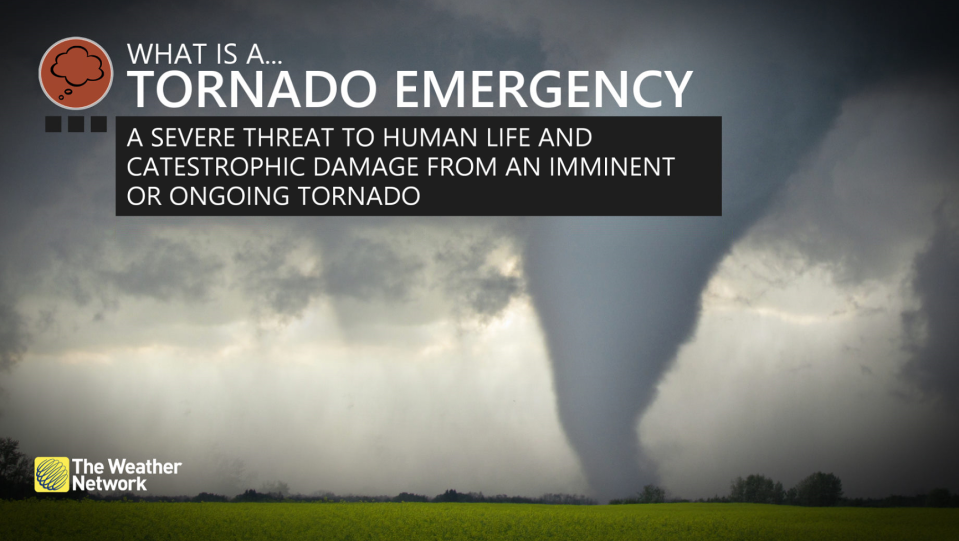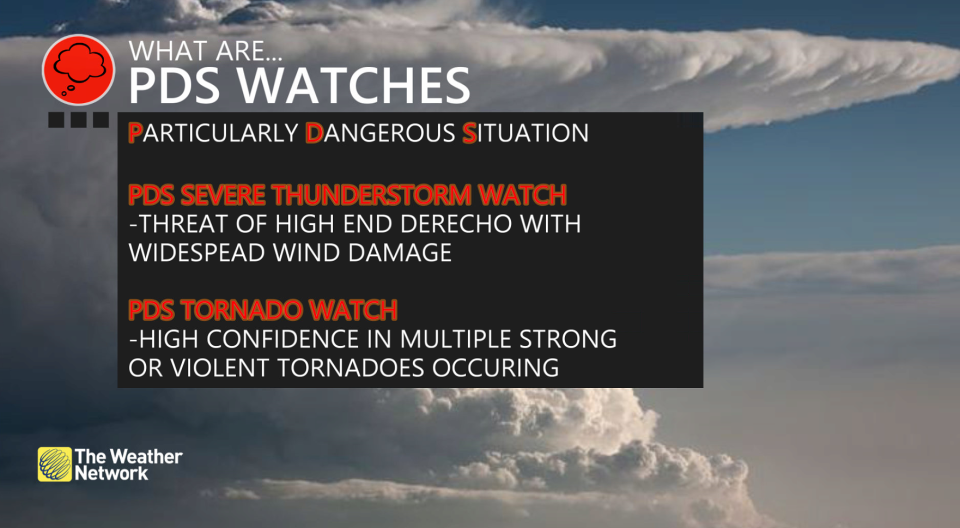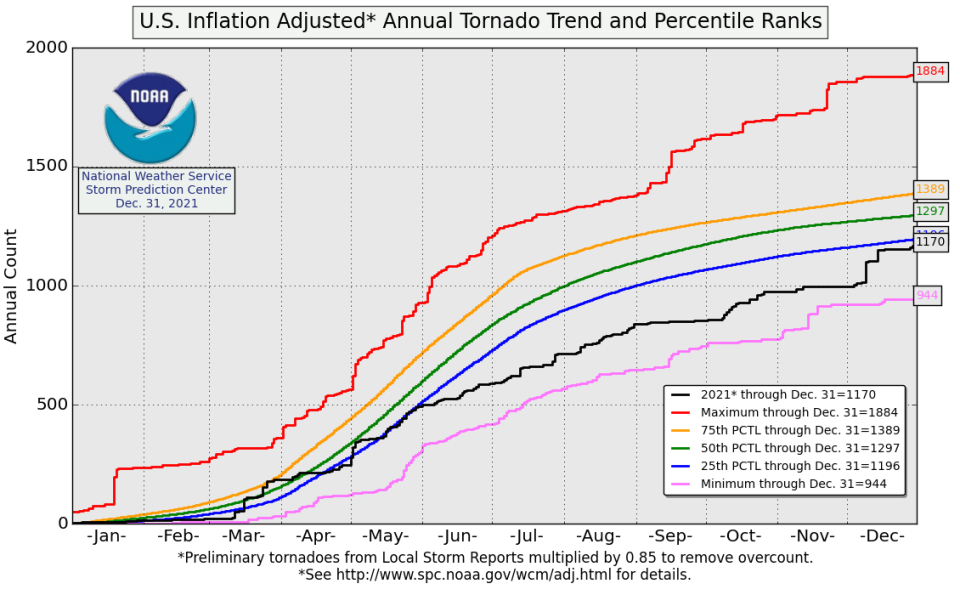‘This is a tornado emergency’: How forecasters warn of grave danger

---
Black clouds filled the southern sky on that muggy May afternoon. Residents of Oklahoma City watched nervously as local meteorologists frantically called out the next cities and streets in line for destruction. “You need to be underground,” one said. Then came the words nobody expected, and which would shape the future of tornado safety:
“THIS IS A TORNADO EMERGENCY FOR MOORE AND SOUTH OKLAHOMA CITY.”
Those two words—tornado emergency—were a spur of the moment effort by forecasters to convey the grave danger residents faced in the path of this F5 tornado that had grown more than one-and-a-half kilometres wide.
Dozens of people died in the historic tragedy on May 3, 1999. Entire neighbourhoods were scoured down to the soil. And those final two words before disaster struck went on to form the basis for the most chilling alert anyone in harm’s way can receive.
RELATED: Watch? Warning? How we communicate severe weather in Canada
Watches vs. Warnings
Knowing the difference between a watch and a warning could save your life in an emergency.

A tornado or severe thunderstorm watch means that conditions are favourable for the development of severe weather within the next couple of hours.
A tornado or severe thunderstorm warning means that a dangerous storm is imminent and you have to seek shelter right away to stay safe.
A watch means to prepare. A warning means to take action immediately.
It’s always important to take every watch and warning seriously. There are some situations, though, that require even stronger wording.
Warnings are slightly different in Canada and the United States
Environment and Climate Change Canada (ECCC) and the U.S. National Weather Service (NWS) each use different criteria to determine what constitutes a severe thunderstorm.
ECCC issues severe thunderstorm warnings for heavy rainfall, for instance, while the NWS only issues them for damaging winds and large hail.
Another difference is that the NWS issues warnings using small polygons targeting only areas in the storm’s immediate path, while ECCC issues warnings that cover much larger areas.
Ever wonder how tornadoes are tracked in Canada? We're LIVE with @nadinehp4 @gregoryalankopp @dave_sills & @Albatrossoar answering your questions about severe weather ⛈🌪🇨🇦 @westernuNTP @westernuNHP @WesternU https://t.co/3Z14DzRgqT
Ever wonder how tornadoes are tracked in Canada? We're LIVE with The Weather Network on Twitter: "Ever wonder how tornadoes are tracked in Canada? We're LIVE with @nadinehp4 @gregoryalankopp @dave_sills & @Albatrossoar answering your questions about severe weather ⛈🌪🇨🇦 @westernuNTP @westernuNHP @WesternU https://t.co/3Z14DzRgqT / Twitter" The Weather Network on Twitter: "Ever wonder how tornadoes are tracked in Canada? We're LIVE with @nadinehp4 @gregoryalankopp @dave_sills & @Albatrossoar answering your questions about severe weather ⛈🌪🇨🇦 @westernuNTP @westernuNHP @WesternU https://t.co/3Z14DzRgqT / Twitter" The Weather Network on Twitter: "Ever wonder how tornadoes are tracked in Canada? We're LIVE with @nadinehp4 @gregoryalankopp @dave_sills & @Albatrossoar answering your questions about severe weather ⛈🌪🇨🇦 @westernuNTP @westernuNHP @WesternU https://t.co/3Z14DzRgqT / Twitter" & The Weather Network on Twitter: "Ever wonder how tornadoes are tracked in Canada? We're LIVE with @nadinehp4 @gregoryalankopp @dave_sills & @Albatrossoar answering your questions about severe weather ⛈🌪🇨🇦 @westernuNTP @westernuNHP @WesternU https://t.co/3Z14DzRgqT / Twitter" answering your questions about severe weather ⛈🌪🇨🇦 The Weather Network on Twitter: "Ever wonder how tornadoes are tracked in Canada? We're LIVE with @nadinehp4 @gregoryalankopp @dave_sills & @Albatrossoar answering your questions about severe weather ⛈🌪🇨🇦 @westernuNTP @westernuNHP @WesternU https://t.co/3Z14DzRgqT / Twitter" The Weather Network on Twitter: "Ever wonder how tornadoes are tracked in Canada? We're LIVE with @nadinehp4 @gregoryalankopp @dave_sills & @Albatrossoar answering your questions about severe weather ⛈🌪🇨🇦 @westernuNTP @westernuNHP @WesternU https://t.co/3Z14DzRgqT / Twitter" The Weather Network on Twitter: "Ever wonder how tornadoes are tracked in Canada? We're LIVE with @nadinehp4 @gregoryalankopp @dave_sills & @Albatrossoar answering your questions about severe weather ⛈🌪🇨🇦 @westernuNTP @westernuNHP @WesternU https://t.co/3Z14DzRgqT / Twitter" The Weather Network on Twitter: "Ever wonder how tornadoes are tracked in Canada? We're LIVE with @nadinehp4 @gregoryalankopp @dave_sills & @Albatrossoar answering your questions about severe weather ⛈🌪🇨🇦 @westernuNTP @westernuNHP @WesternU https://t.co/3Z14DzRgqT / Twitter"
— The Weather Network (@weathernetwork) The Weather Network on Twitter: "Ever wonder how tornadoes are tracked in Canada? We're LIVE with @nadinehp4 @gregoryalankopp @dave_sills & @Albatrossoar answering your questions about severe weather ⛈🌪🇨🇦 @westernuNTP @westernuNHP @WesternU https://t.co/3Z14DzRgqT / Twitter"
Size difference aside, tornado warnings are pretty much the same in both countries. ECCC and the NWS will both issue a tornado warning if meteorologists detect strong rotation on weather radar, or if spotters following a thunderstorm report seeing a tornado.
ECCC uses the same language in pretty much all of its tornado warnings. The NWS, on the other hand, can use enhanced warning to convey the grave danger a storm poses to folks who are under a tornado warning.
It’s important to know about these enhanced warnings if you’re ever visiting south of the border.
Tornado emergency: Enhanced wording to convey grave danger
Meteorologists have to study people almost as much as they study the weather. For as complicated as storms are, finding the right words to talk about them can be just as much of a challenge.
Balancing the need to convey accurate information while avoiding hyperbole or the “crying wolf” effect is a tough job under everyday circumstances, let alone in the midst of a life-threatening emergency.
The NWS reserves a handful of special phrases to use in their severe weather watches and warnings during the most serious threats to life and property.

The term tornado emergency, coined by NWS Norman, Oklahoma, during that fateful 1999 outbreak, is the most well-known intensifier in a U.S. forecaster’s arsenal.
A tornado emergency is only “issued when there is a severe threat to human life and catastrophic damage from an imminent or ongoing tornado,” according to the agency. This ominous phrase is added off the top of a tornado warning where it can be easily seen and heard on television, radio, and weather apps.
Issuing one of these rare alerts is a multi-step process that forecasters in the hot seat don’t take lightly. Over the past couple of decades, meteorologists have only issued about two hundred tornado emergencies, covering some of the most destructive tornadoes in recent memory.
WATCH: These tornado safety tips could save your life
’This is a particularly dangerous situation’
Declaring a situation a “tornado emergency” isn’t the only way meteorologists can highlight the severity of impending storms.
While local NWS offices are responsible for issuing warnings for individual thunderstorms, the U.S. Storm Prediction Center (SPC) is the agency tasked with issuing severe thunderstorm and tornado watches several hours before storms arrive.
STAY PREPARED: Everyone needs a home emergency kit. Here's what to stock yours with
These watches include information letting residents know what hazards to expect if they encounter a severe thunderstorm. Under the most extreme circumstances, the SPC will declare a watch a “particularly dangerous situation,” or PDS for short.

A PDS tornado watch means that conditions are favourable for storms to produce multiple strong, long-lived tornadoes.
A PDS severe thunderstorm watch means that folks in harm’s way can expect a high-end derecho, or a long-lived squall line that produces extensive damaging wind gusts along its path.
Only a small percentage of watches in the United States receive this enhanced wording. The SPC can issue numerous PDS severe thunderstorm and tornado watches during an active severe weather year.
Local NWS offices recently adopted this PDS wording to use in severe thunderstorm and tornado warnings for storms that are especially destructive but don’t quite rise to the level of a tornado emergency. These PDS warnings are usually reserved for confirmed tornadoes or severe thunderstorms with extremely destructive wind gusts of 130+ km/h.
It’s important to know these terms if you travel south of the border
It’s important to keep the existence of these alerts in the back of your mind if you plan on travelling to the United States. Many Canadians travel to the U.S. throughout the year, especially to destinations where tornadoes are common.

Tornado activity is common year-round in the United States, including during the heart of winter. (NOAA/SPC)
Always be aware of your surroundings and keep tabs on local weather forecasts. Keep severe weather safety in mind as you go about your day so you’re prepared if a dangerous storm looms on the horizon.
Make sure you have a way to receive severe weather alerts the moment they’re issued, no matter where you live or where you’re visiting. The Weather Network's app is a great resource for severe weather alerts in both Canada and the U.S.


